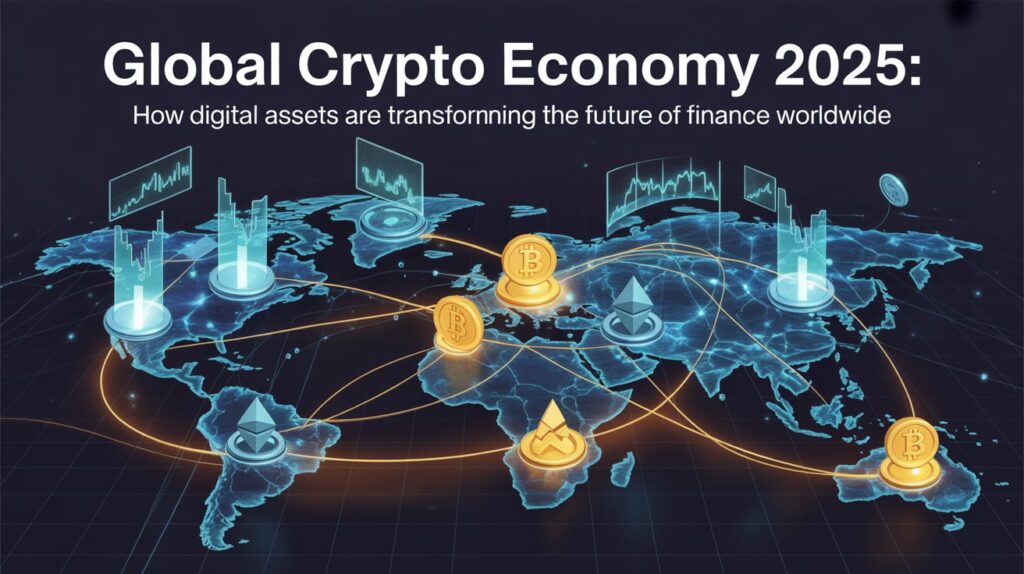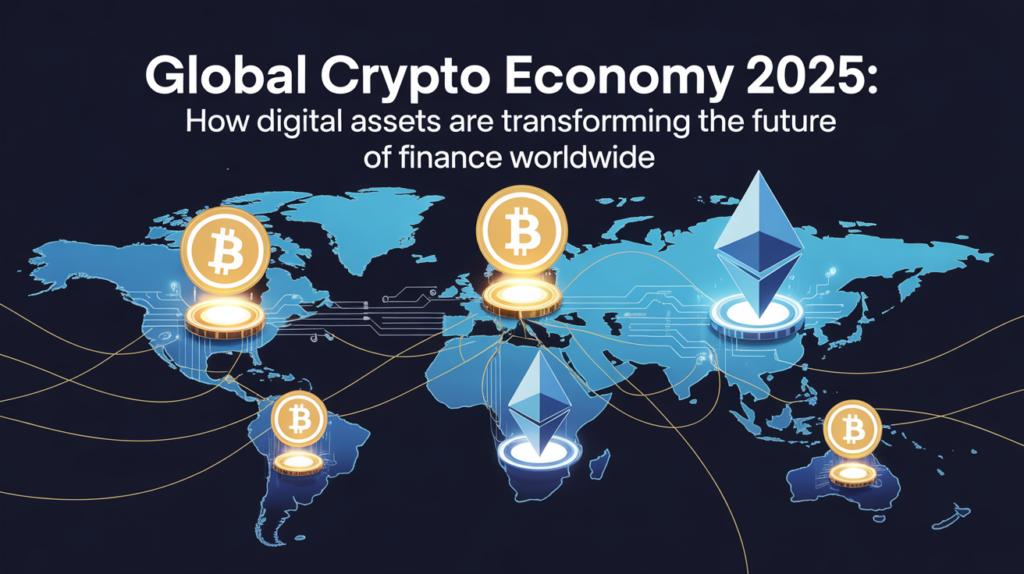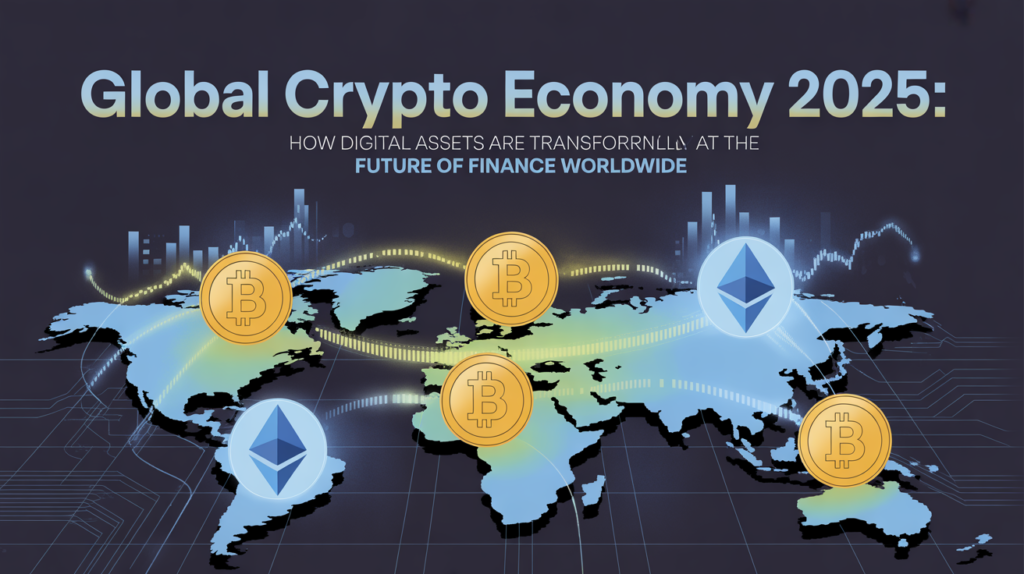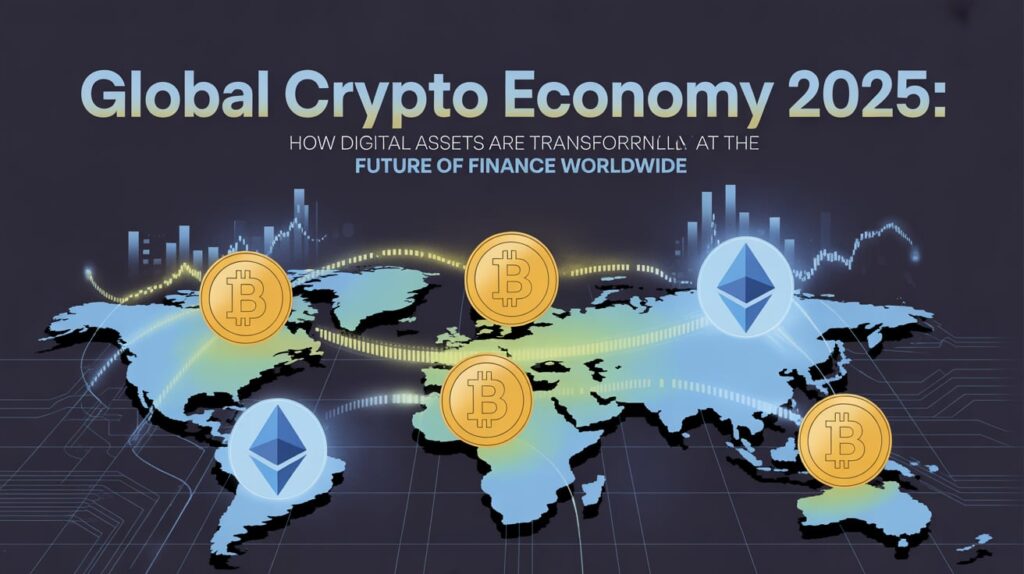Global Crypto Economy 2025: How Digital Assets Are Transforming the Future of Finance Worldwide
The global crypto economy is no longer a niche experiment — it’s a massive, evolving ecosystem reshaping how money moves, how value is created, and how people interact financially. From decentralized finance (DeFi) to digital currencies issued by central banks (CBDCs), the crypto landscape is pushing the world toward a borderless, digital-first financial era.
In 2025, cryptocurrency is at the heart of conversations between banks, governments, investors, and innovators alike. Bitcoin remains the king, but it’s the entire ecosystem — altcoins, DeFi, Web3, stablecoins, and tokenized assets — that’s fueling the next wave of growth.

🌍 1. The Big Picture: A Trillion-Dollar Transformation
As of October 2025, the total crypto market capitalization fluctuates between $2.8 and $3.1 trillion, with Bitcoin holding around 47% dominance. Ethereum, Solana, and emerging L2 networks continue driving innovation through smart contracts and real-world asset tokenization.
Unlike the speculative craze of 2021, today’s market growth is powered by infrastructure, adoption, and utility — not just hype. Corporations, governments, and retail users are now using blockchain technology in real business processes, payments, and identity systems.
“Crypto isn’t just a trade — it’s a transformation of the global economy,” says a recent report by CoinMetrics.
💸 2. Bitcoin: Still the Global Standard
Bitcoin continues to define the narrative for the crypto market. Despite massive volatility earlier this year, BTC’s price rebounded above $120,000, largely driven by institutional accumulation and the approval of additional U.S. Bitcoin ETFs.
Why Bitcoin Still Leads:
-
Scarcity & Trust: With a fixed 21 million supply, Bitcoin acts as digital gold.
-
Institutional Entry: BlackRock, Fidelity, and other global funds continue expanding their crypto portfolios.
-
Macro Hedge: In economies with inflation and currency instability, Bitcoin acts as a safe haven.
From Wall Street to Lagos, Bitcoin isn’t just a speculative bet — it’s becoming a global reserve alternative, particularly in developing economies where local currencies struggle.
🪙 3. Altcoins & Layer-2s: The New Innovation Frontier
While Bitcoin builds credibility, altcoins build functionality.
Ethereum leads with DeFi, NFTs, and tokenized assets, but newer players — like Solana, Avalanche, and Optimism — are changing the performance game.
🔹 Key Trends in Altcoin Ecosystem:
-
Layer-2 Scaling: Networks like Arbitrum and Base are reducing transaction costs by over 80%.
-
Cross-Chain Bridges: Interoperability allows liquidity to flow seamlessly between chains.
-
Real-World Assets (RWA): Real estate, treasury bonds, and commodities are being tokenized and traded 24/7 on blockchain.
The altcoin ecosystem now looks less like a casino and more like a tech industry — complete with product cycles, users, and revenue models.

🏦 4. The Rise of Institutional Crypto Adoption
Institutions are no longer sitting on the sidelines.
2025 has seen banks like JPMorgan, HSBC, and Deutsche Bank roll out blockchain-based payment solutions and custody services. In the U.S., regulated ETFs and custody frameworks opened the door for pension funds and corporate treasuries.
🔸 Corporate Use Cases:
-
Settlement & Payments: Instant international transfers without intermediaries.
-
Treasury Management: Holding Bitcoin and stablecoins as part of diversified reserves.
-
Smart Contracts in Trade Finance: Reducing paperwork, fraud, and delays.
According to Deloitte’s 2025 survey, 67% of financial institutions now have active blockchain pilots or crypto investments.
⚖️ 5. Regulation: The Double-Edged Sword
Crypto regulation continues to evolve across regions — sometimes helping, sometimes hindering.
🔹 United States:
-
The Digital Asset Framework Act 2025 brought clearer tax and reporting standards.
-
Spot Bitcoin ETFs were approved, but privacy coins face ongoing scrutiny.
🔹 Europe:
-
The MiCA (Markets in Crypto-Assets) regulation went live, standardizing crypto laws across the EU.
-
Focus on stablecoin reserves and consumer protection boosted investor confidence.
🔹 Asia:
-
Hong Kong and Japan embraced pro-crypto licensing.
-
India and China continued to explore state-backed digital currencies (CBDCs).
Regulation now defines market maturity — and projects that comply attract bigger institutional and retail participation.
🌐 6. Web3 & DeFi: Powering the Next Financial Layer
The Web3 revolution is redefining how ownership, identity, and value transfer work online.
DeFi platforms — like Aave, Uniswap, and Compound — have become financial ecosystems on their own. The total value locked (TVL) in DeFi protocols surpassed $230 billion globally in Q3 2025.
🔸 Emerging DeFi Trends:
-
Automated Yield Aggregators: Smart contracts finding the best yield opportunities across chains.
-
Decentralized ID (DID): Users verifying themselves without central databases.
-
Hybrid DeFi Models: Projects integrating KYC for institutional participation.
DeFi’s promise? Cutting out middlemen and allowing anyone with an internet connection to access finance — borderless, permissionless, and transparent.

💱 7. Stablecoins & CBDCs: The Bridge Between Old and New Finance
Stablecoins (like USDT, USDC, and PYUSD) dominate crypto payments, representing over 60% of total on-chain transaction volume.
Meanwhile, CBDCs (Central Bank Digital Currencies) are emerging as the next big experiment in global finance.
The U.S., China, and the EU are piloting state-backed digital currencies designed for faster, traceable, and programmable payments.
🔹 Why This Matters:
-
Stablecoins provide liquidity to crypto markets and bridge to fiat systems.
-
CBDCs represent governments’ bid to maintain control in a digitized economy.
The tension between the two will shape global finance — decentralization vs. control.
🪩 8. Global Impact: How Crypto Is Changing Economies
🌎 North America
-
Leading in regulation, institutional adoption, and DeFi innovation.
-
U.S.-based ETFs and blockchain-friendly states (Texas, Wyoming) attract new startups.
🇪🇺 Europe
-
MiCA law unified crypto operations, making Europe a regulatory benchmark.
-
France and Germany are seeing corporate-level tokenization projects.
🇮🇳 Asia
-
India ranks among the top 3 crypto users by volume despite high taxation.
-
Singapore remains the region’s fintech hub.
🌍 Africa
-
Countries like Nigeria and Kenya lead in P2P Bitcoin adoption.
-
Crypto remittances help bypass high transfer fees and inflationary local currencies.
🌎 Latin America
-
El Salvador still pioneers with BTC as legal tender.
-
Argentina’s inflation continues pushing citizens toward stablecoins.
This global diversification means crypto isn’t a Western phenomenon — it’s a universal movement reshaping economies everywhere.

🧠 9. The Psychology Behind Crypto Adoption
Why are millions still entering crypto despite volatility?
-
Trust in Math Over Institutions – Users prefer transparent, code-based systems.
-
Freedom of Finance – Self-custody appeals to users tired of banking restrictions.
-
Community & Culture – Memecoins, NFTs, DAOs — all blend finance with entertainment.
Crypto isn’t just tech — it’s a philosophy: open, decentralized, and user-empowered.
🚀 10. The Future of the Global Crypto Economy
By 2030, analysts predict that over 1 billion people will use blockchain-based applications.
The world is entering a multi-chain, tokenized, programmable economy, where value flows as easily as information.
🔮 Future Outlook:
-
Tokenization of Everything – Stocks, art, carbon credits, real estate on-chain.
-
AI + Crypto – Autonomous finance driven by smart algorithms.
-
Regulated DeFi – Institutional-friendly DeFi with identity layers.
-
Sustainable Mining – Green crypto powered by renewable energy.
-
Global Financial Inclusion – Crypto banking for the unbanked.
In the next decade, the crypto economy won’t just coexist with traditional finance — it will merge with it.
💬 Final Thoughts
The global crypto economy is no longer a concept — it’s a living system evolving in real time. Whether you’re an investor, developer, policymaker, or simply a crypto enthusiast, one thing’s clear:
The next decade belongs to those who understand digital value.
Stay curious, stay cautious, and keep learning — because the revolution isn’t coming… it’s already here.